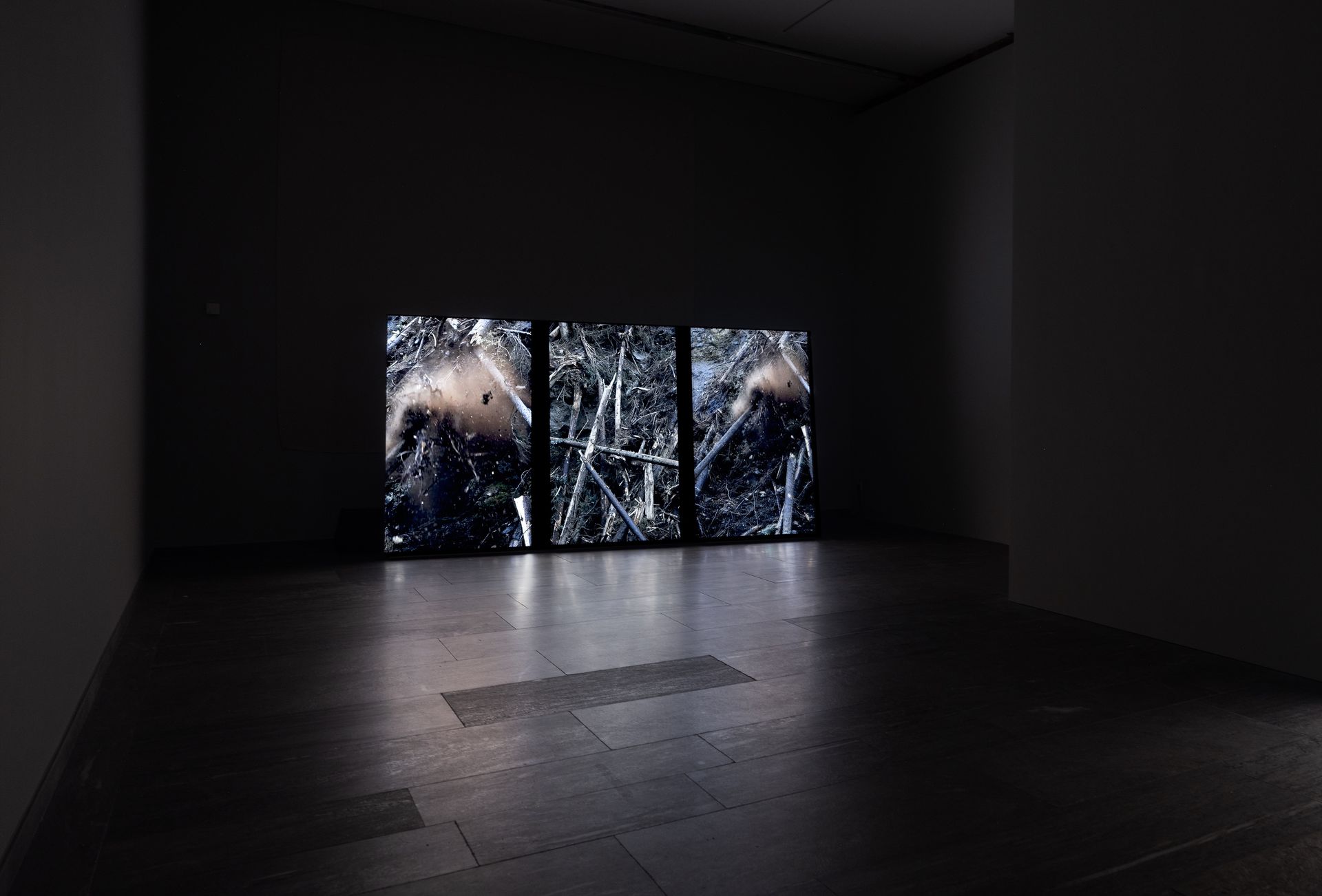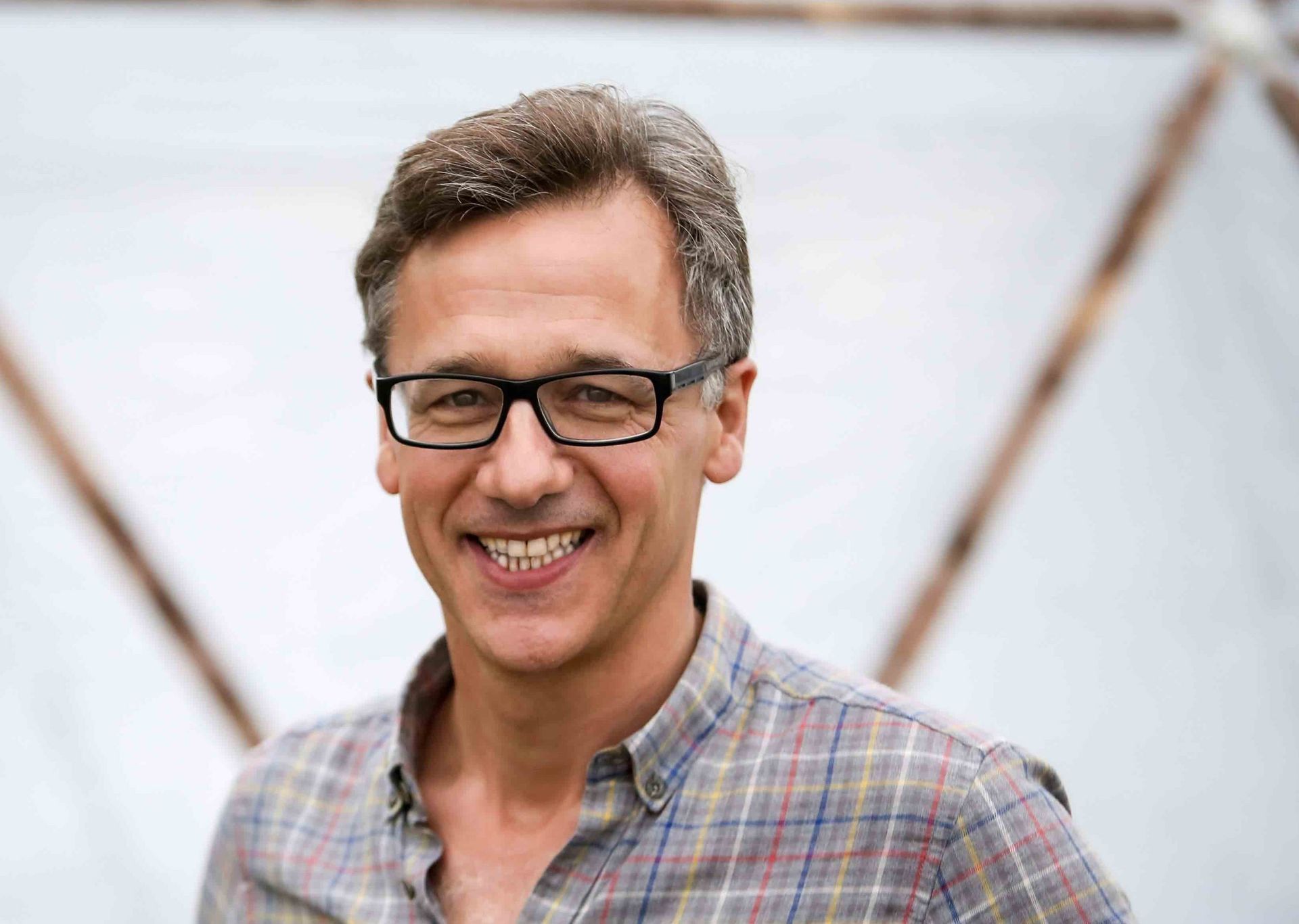
©Andreas Moser
Uta Kögelsberger: "The human-made, often industrial forests are a reminder of what we have already lost."
Forest Complex is the new project by London-based artist Uta Kögelsberger. Her artistic practice focuses on the social and political effects of climate change and its impact on forests, which she expresses in photography, videos and sculptural sound installations. For Kögelsberger, climate change is at the heart of all the pressing issues of our time. The subject matter of Forest Complex follows on from Fire Complex and Cull, which attracted worldwide attention and for which she received the prestigious Royal Academy Wollaston Award. Fire Complex was a response to the 2020 Castle Fire in California, which destroyed 174,000 hectares of forest and 14% of the world's Giant Sequoia population. Kögelsberger herself lost her house in the fire. Her replanting effort mobilised local communities, and in that contributed amongst others to a new bill being introduced to Congress to protect giant sequoias.
Due to recognition she had achieved through Cull, she was contacted by Hans Joachim Gögl the curator of Inn Situ at the BTV Stadtforum in Innsbruck to develop a project about the Alpine forests in Austria. Forest Complex, a project for which the artist meticulously visited and documented the region for months, opened at INN SITU in Aopril. In this programme series, international artists are invited by the BTV to respond to the Tyrol/Vorarlberg region. Forest Complex had its premiere on 17 April. In her slideshow installation Roots, she was able to document the massive consequences of the 2018 storm Vaia, which destroyed 15 million trees in the Alpine forests, and the subsequent process of reconquest by the environment. At the same time as her project, Austria relaxed its climate policy and introduced the "Klimafitter Wald" initiative, the testing of new tree species for a forest adapted to climate change.
5 May 2024

Forest Complex ©Uta Kögelsberger
"It may take thousands of years to build an ecosystem, but it only takes a fraction of that to destroy it."
Can you describe your feelings when you walk in a forest?
There are many kinds of forests. Each creates a different kind of experience. The Giant Sequoias Groves of the American West, with their trees that are over 3000 years old, make the difference between the human time versus the time of ‘nature’ palpable. In contrast to that in Tyrol 97 per cent of the forests have already been shaped by human agency. Most of them are second or third generation monocultures. These human-shaped, often industrial forests are a reminder of what we have already lost. They stand in contrast to the towering mountains with their receding glaciers. Here, human time is literally rubbing up against geological time. As the ice retreats from the rock, one reality replaces the other. It may take thousands of years to grow an ecosystem, but it only takes a fraction thereof to destroy it. In a society driven by speed, we are incredibly slow to react when it comes to climate change. How can we possibly justify such a double standard?
Why did you choose the climate as your artistic theme?
It is at the heart of all the pressing issues of our time. If we can't solve the problem of climate change, all other social problems will get much worse.
"Fire Complex was a project that started from the personal to reflect on a global emergency. “
Your new project follows on from Cull, where you portrayed the Sequoia National Forest in California. What brought you to the Alps now?
The work you mention followed the clean-up after the 2020 Castle Fire in California. It destroyed 174,000 acres of forest, 14% of the world's Giant Sequoia population and half of the homes in our community in the US, including ours. It was devastating on so many levels. Fire Complex was a project that started from the personal to reflect on a global emergency. It took place in the public realm, in the galleries and as a form of activism, including a community-based replanting effort. According to employees of USDA Forest Services, our ability to mobilise constituents as part of Fire Complex contributed to a new bill being introduced to Congress. The bill did not pass yet but it gave Forest Services the necessary leverage to undertake some fire prevention emergency measures in Giant Sequoia Groves. Cull, the anchor piece, of Fire Complex then went on to win the Royal Academy Wollaston Award.
Following this project, I was contacted by the curator of Inn Situ, Hans Joachim Gögl. We got talking about a possible project in Austria that would address the pressures Alpine forests have come under as a result of human-made climate change. I was very interested in continuing the work I had started in the US in a different context and ecosystem. This was the perfect opportunity

Forest Complex ©Uta Kögelsberger

Forest Complex ©Uta Kögelsberger
"These forests are threatened by the pressures of climate change. They are particularly vulnerable because they are monocultures."
Can you tell the readers something about your research findings?
I spent months talking with forestry experts, farmers, and labourers to gain a better understanding of the relationships between forests and forest management in Austria. What revealed itself was a complex web of relations. Let me try to summarise them:
Due to the proximity of human habitation and "nature" in Tyrol, the forests fulfil the critical safety function of literally holding the mountains together. These forests are coming under threat with the pressures of climate change. They are particularly vulnerable because they are monocultures. In addition, the dominant species, the spruce tree, has shallow roots system, which means that it struggles with rising temperatures and finds it more difficult to access groundwater. A struggling tree is more susceptible to bark beetle infestation. There used to be one generation of bark beetles per year, but with rising temperatures we are seeing three generations per year. To make matters worse, human-made climate change is leading to more severe weather events with stronger winds from new directions, which regularly bring down large parts of the forests. These uprooted trees are the perfect fodder for the bark beetle.
In July 2023 we saw many of these human-made climate change related extreme storms. It was incredibly impressive to witness the amount of energy that forestry services and individuals are investing into recovering these areas after the storms. This is partly due to the lessons learnt from Storm Vaia, the aftermath of which triggered a massive increase in bark beetle infestations. It is now recognised that it is vital to remove the trees toppled by the storms as quickly as possible. The cost of these clear out processes is as staggering as it is complex and dangerous.
In the exhibition Forest Complex, this is explored through the three-channel video installation Cull, which follows this process of recovery after destruction using the example of the clearing of the Haselbach Gorge. The Haselbach Gorge is a 150-deep gorge with particularly steep slopes, so steep that the trees had to be ripped from its sides by helicopter. As it was too expensive to then also remove them from the site by helicopter, they were dropped into the gorge where they then posed a flood risk. Thus, they had to be lifted out of the ravine one by one. In Clearance you witness a single man as he is undertaking the Sisyphean task of pulling one tree after another out of the gorge over a period of two months. The extremely dangerous labour process is also the reason why it is becoming increasingly difficult to find workers willing to take on this work.
"The critical point is that the people most affected by these storms are not the same people who create the conditions that devastate these forests."
The other aspect that is important in the context of the impact of climate change on the Alpine forests is, of course, the impact on the economy. Because of the structure of inheritance law in Austria, many of the foresters own small plots of forest that have acted as their savings accounts in the past. However, due to the large quantities of damaged timber flooding the market, the price of timber has fallen drastically.
This is aggravated by the cost of the clear up process. Instead of making money on their forests the farmers are lucky to cut even. This is the subject of the single channel video Woodworks, which is exhibited alongside Clearance. It follows the next stage of the wood as it arrives at the woodyard of one of the largest wood conglomerates of Europe where it is turned into a marketable product. The people affected by these economic effects are the subjects of the video work Portraits.
"I think it's important that we as a society re-evaluate how we compensate the people who take care of this environment on behalf of society."
The critical point here is that those most affected by these storms are not the same people who create the conditions that devastate these forests. We are all responsible - but some suffer more than others. I think it's important that we as a society re-evaluate how we compensate those people who are looking after the environment on behalf of society so as to ensure the futures of these environments. And I am saying this is the most widespread geographical sense possible.
Is your new project supported by the government?
I was commissioned to develop new work for an exhibition at the BTV Stadforum. They commission 2 international artist-photographers a year to develop new work in response to Tyrol. The curator Hans Joachim Gögel has developed a very interesting model for these exhibitions, which includes a commission for a Tyrol-based musician to develop a new composition in direct response to the work in the exhibition, a series of talks with experts working in non-art fields and a book published by Fotohof. In addition to the excellent framework provided by BTV, the project was supported by the forestry services. Especially in practical terms, by supporting the research, providing access to resources, and putting me in touch with people directly involved with the forests.
"For me, it reflects the complexity of the processes of destruction and reconstruction that humanity has set in motion, not only in relation to our forests, but to the environment in general."
This time, the artwork is accompanied by an Italian early Baroque concerto. Is this an allusion to Innsbruck?
The final concluding part of the 20-minute 3-channel video Clearance is accompanied by Bach's Cello Suite. This cello suite is both mournful and uplifting, sad and hopeful. For me, it reflects the complexity of the processes of destruction and reconstruction that humanity has set in motion, not only in relation to our forests, but to the environment in general.
"Moi, je t'offrirai/ Des perles de pluie/Venues de pays/ Où il ne pleut pas“
It is this cycle of destruction and reconstruction that is at the centre of the exhibition. There are other sound elements in the exhibition. For example the sound installation Treework is based on new research that shows that plants emit ultrasound when they are under duress. This work recorded the sounds trees emit when they are infested with bark beetles. It is a simple installation of two loudspeakers that broadcast this sound throughout the exhibition. Another work is based on research that claims that plants grow faster and develop a stronger immune system when exposed to music. In this work, a young girl sings the song "Ne me quitte pas" by Jacques Brel to the forest with her crystal-clear voice. She literally begs the forest not to leave her and offers it the impossible: "Moi, je t'offrirai/ Des perles de pluie/ Venues de pays/ Où il ne pleut pas" (I, will offer you/ Pearls of rain/ Coming from countries/ Where it never rains).
"My hope is that society, the economy, and the population can adapt in time.“
It takes place at the same time as the Climate Biennale in Vienna. A happy coincidence?
That's the case, and it's no coincidence. The momentum which work related to the climate emergency is gathering is more of a symptom than anything else. It shows how urgent the climate crisis has become. We are at the tipping point. We find ourselves at the beginning of experiencing the impact of a now irreversible trend.
My hope is that society, the economy, and the population can adapt in time, especially in relation to our forests. : During the time I was working with the Tyrolean forests, Austria relaxed its policies around testing new species of trees for a climate change adapted forest (Klima fitter Wald). It is this kind of initiative, and in general the investment of individuals that I witnessed in the process of this projects that gives me hope.
TOP STORIES
PHOTOGRAPHY
Without censorship: World Press Photo publishes the regional winners of the 2024 photo competition
_____________
FLORENCE
_____________
April 2024
DÜSSELDORF
Controversy surrounding the Düsseldorf Photo Biennale
_____________
WAR
March 2024
_____________
ISRAEL
November 2023
_____________
LUXURY
US high-end furnishing giant RH The Gallery opens in Düsseldorf with star guests.
November 2023
_____________
ENGLISH CHRISTMAS
10 years of Glow Wild at Kew Wakehurst.
October 2023
_____________
TRIENNALE MILANO
Pierpaolo Piccioli explains his fascination with art.
_____________
NEW MUSEUMS
29 May 2023
_____________
NEW MUSEUMS
is coming in big steps.The Bernd and Hilla Becher Prize will be awarded for the first time.
19 May, 2023
_____________
VISIONS, ARCHITECTURE
MARCH 10, 2023
_____________
CHECK THE THINGS YOU WANT TO THROW AWAY
HA Schult's Trash People at the Circular Valley Forum in Wuppertal on 18 November 2022.
NOVEMBER 19, 2022
_____________
THE OPERA OF THE FUTURE
Düsseldorf, capital of North Rhine-Westphalia will receive the opera house of the future.
FEBRUARY 15, 2023
_____________
FLORENCE
The extraordinary museums of Florence in 2023.
JANUARY 1, 2023
_____________
DÜSSELDORF
DECEMBER 11, 2022
_____________
DISTANT WORLDS
Dieter Nuhr's paintings now in Senegal - "A Nomad in Eternal Transit"
RELATED TALKS






